September 30, 2019
 by Tom Winter / September 30, 2019
by Tom Winter / September 30, 2019

When hiring new employees, are you aware of ALL the skills they have or just a fraction of them?
The truth is, most employers associate their employees with the skills listed in the job description they hired them for. Without a doubt, tracking the skills of employees poses serious problems, even to small organizations. There is, however, a straightforward way to track employee skills and how they progress. It’s called competency mapping.
The awareness of what your employees can or cannot do that comes from competency mapping can be leveraged to achieve multiple goals. In this article, we’re taking a close look at what competency mapping is, how it can benefit the employees and employers, and how to get started.
Competency mapping is a strategy focused on evaluating the competencies of employees in a structured and repeatable way. One of the main goals is to gain awareness of the current skills inventory in the organization, as well as identify existing skill gaps.
That said, following American organizational theorist and professor Richard Boyatzis, competencies are not synonymous to hard skills:
“A job competency is an underlying characteristic of a person in that it may be a motive, trait, skill, aspect of one’s self-image or social role, or a body of knowledge which he/she uses. The existence and possession of these characteristics may or not be known to the person.”
For this reason, competency mapping can be used across types of roles. The data gathered in the process of mapping competencies is typically used by managers, HR professionals, team leads, and of course, employees.
Competency mapping data can be stored and presented in a number of ways, from simple spreadsheets to competency mapping software.
The concept of competency mapping is inseparable from skill maps and career paths, which draw heavily from the world of gaming. Let’s now take a closer look at these terms.
Skill maps are the product of competency mapping. They provide a visual representation of the skill inventory, skill progressions, and sometimes growth opportunities. Example? In Civilization, prerequisite skills are necessary to obtain before more advanced skills. If you want to build and navigate ships, you have to be able to use a hammer and have a decent understanding of mathematics and astronomy.
Similarly, if you want to become a senior iOS developer, you need to have the skills typically associated with junior and senior iOS developer roles.
Here’s an example of a developer skill map:

Let’s now look at career paths.
Career paths are visual representations of the steps needed to take to get to the desired position. They typically define the progressions associated with making career advancements such as the skills, certifications, or subsequent positions.
Here’s a great example of a Human Resources career path:
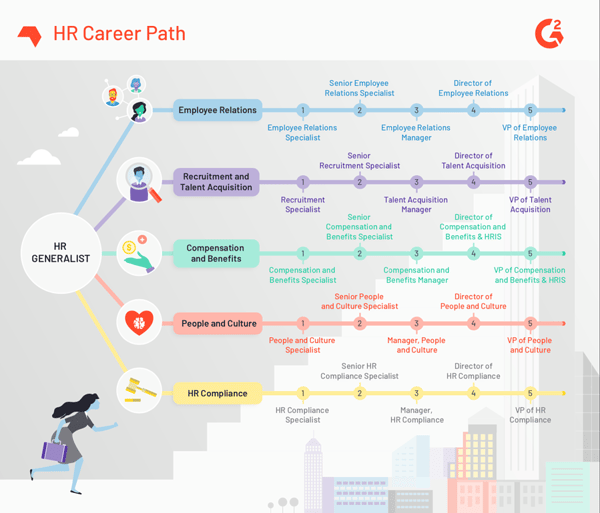
If you and your company are new to the concept of competency mapping, getting started can be quite overwhelming. The good news is that you can take some simple steps to reap the benefits of competency mapping.
From an organizational perspective, you don’t need to start scheduling additional meetings your employers will be stressed or skeptical about (or likely both). You can start by simply adding some questions to the periodical assessments you’re likely already have planned. Then record your findings in a simple spreadsheet or dedicated competency mapping software.
Competencies can be assessed at the number of stages:
| Recruitment |
| Assessment during further development |
| Succession planning and promotion |
| Organizational development analysis |
Benefits for the employee include awareness of the long term plan of the company and the long term plan for your own development and managing expectations.
The companies that map skills typically have advanced planning capabilities. They often have a well-defined growth plan and they use competency mapping to get where they want to be. On the micro scale, this is beneficial to the employees who are able to see the next steps their careers will take. On the macro scale, knowing the long term plan, the mission, and vision of the company makes people more engaged in their jobs.
Defining the natural progression of employees' skills provides clear rules of what’s expected from them. It also shows how the steps they take will affect their careers. For example, in the context of employee assessment, the evaluation of progress is based on universal, objective rules that are known upfront. This takes the stress out of the evaluation process.
Employers can close skill gaps with employee training programs which nurture the growth of new capabilities to be used on the job. This is beneficial to the employees who are given the chance to advance their skills at work, be it through training, certification, or training budgets.
Education and certification opportunities are a strong contender when it comes to attracting talent, especially in competitive industries like tech. For example, findings from the 2019 Dice Salary Report suggest that training and education are the biggest gap in important vs. received benefits in the tech industry (31%).
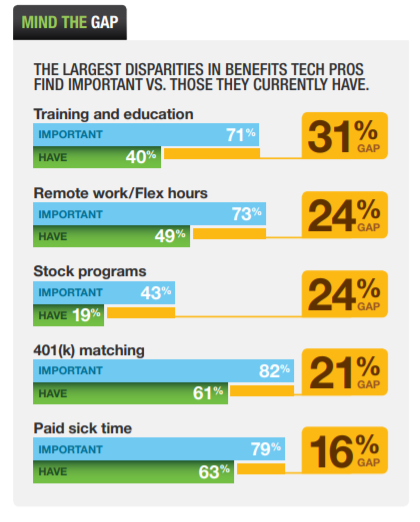
Education opportunities also have a positive impact on retention. LinkedIn’s 2019 Workforce Learning Report discovered that 94% of employees would stay at a company longer if it invested in helping them learn.
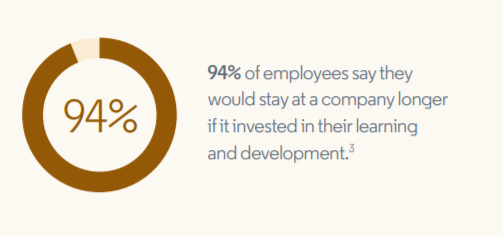
In the very same report, 82% L&D pros reported that their executives actively supported employee engagement in professional learning. This could indicate that learning is more easily available in industries other than tech.
Benefits for the employer include assessing and closing skills gaps and reduced turnover. According to LinkedIn 2019 Workplace Learning Report, understanding skill gaps is the #1 priority this year for talent developers worldwide.

Competency mapping is a surefire way of identifying these skill gaps, but it shouldn’t be the only one. To get skill gaps insights, talent developers “use a multi-pronged approach” including internal assessments, monitoring business KPIs, and meetings with executives and senior managers.
Understanding people’s competencies is crucial when it comes to building great teams. In fact, the word “competencies” is so important in the context of teams, it appears in the definition of the term “team” from The Wisdom of Teams:
"A team is a small number of people with complementary skills who are committed to a common purpose, performance goals, and approach for which they hold themselves mutually accountable."
Once you map the skills people have, you can place them in the right teams to maximize their productivity. Teams made of individuals with complementary competencies are typically more efficient and more satisfied with their jobs. If you want to find out the 5 dynamics of top-performing teams, get acquainted with Google’s findings of their Project Aristotle.

Source: re:work
Being aware of the current skills inventory in your organization allows you to plan your hiring and training activities so you can reach your business goals. Sometimes, to close skill gaps you don’t even need to hire or train someone. You simply look for the person with this skill internally and inquire if they’d like to get involved in a different role.
The common fear employees have is that if they admit to having additional skills, they’ll be given even more work. Educating your employees about the aims of competency mapping in your organization helps to alleviate these fears. Once you do that, you can enjoy your new ability to make optimized decisions when it comes to training and hiring.
According to Workology:
“Person-job-fit (P-J fit) is a structure, which measures the compatibility between an individual’s characteristics (psychological & biological needs, goals, values, personality and abilities) and those of the specific job they are going to do.”
Mapping competencies increases the chances of finding the right fit for a given position because you look at the skills necessary to perform in a given job. Knowing the required vs. nice to have skills is an additional benefit that has a positive impact on your talent pool size.
Eighty percent of employee turnover is a result of bad hiring decisions. Knowing the competencies required to perform well on the job reduces the risk of hiring the wrong person. Sounds logical, right? Still, companies worldwide are struggling to hire the right people.
|
TIP: Read our guide on how to reduce employee turnover along with the top reasons you're experiencing such high rates currently. |
According to a CareerBuilder study of over 6,000 hiring managers, more than half of them “said that a bad hire (...) has negatively impacted their business, pointing to a significant loss in revenue or productivity or challenges with employee morale and client relations.”
Companies that map skills find it a lot easier to present growth opportunities to candidates and new hires.
In the interview scenario, candidates often ask questions like these:
The traditional answer to this question doesn’t provide much insight for the candidate. Companies typically give vague answers along the lines of “If you stay here, at some point you’ll be promoted."This puts the whole organization in bad light.
Now, take a look at this iOS career path from Netguru showing the progressions from a junior to a senior iOS developer (access the site and scroll down to see the path in full, it’s really impressive).
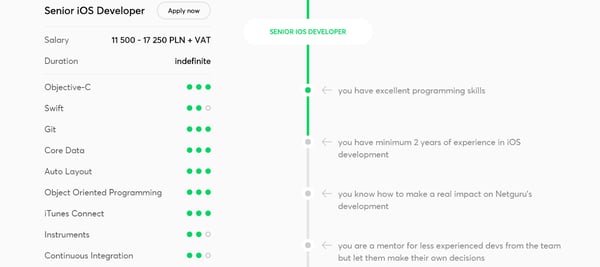
This eliminates most of the guesswork on the candidate’s side and reduces the stress of changing a job.
Companies that map the skills of their employees find it easier to align their training goals with the overall goals of the organization. This means they keep their employees happy and engaged while teaching them to achieve the skills the organization needs to grow.
In the words of Zig Ziglar, “The only thing worse than training an employee and having them leave, is to not train them, and have them stay.”
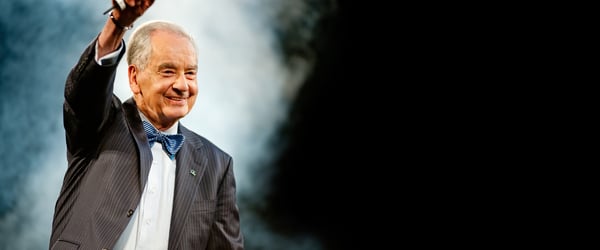
Without mapping the skills and evolvement of your employees, you can’t help them untap their true potential. Competency mapping is a surefire way to improve your human resources efforts.
Need more help coming up with a way to engage, retain, and encourage current and prospective employees? Become an HR expert with our hub, filled with over 35 resources to assure you make the best hiring and training decisions from here forward.
Tom Winter is the CRO at Devskiller, a developer screening and online interviews-in-one platform powered by RealLifeTesting™. Madly in love with everything tech, Tom specializes in streamlining the hiring process of tech talent and data-driven recruitment. He’s also an avid conference speaker.
The war for tech talent continues to grow with no signs of slowing down.
 by Ashmita Roy
by Ashmita Roy
You’ve probably heard time and again that hiring employees in tech is tough. But how tough...
 by Tom Winter
by Tom Winter
Feeling overwhelmed by the ever-changing HR landscape?
 by Sadaf Tanzeem
by Sadaf Tanzeem
The war for tech talent continues to grow with no signs of slowing down.
 by Ashmita Roy
by Ashmita Roy
You’ve probably heard time and again that hiring employees in tech is tough. But how tough...
 by Tom Winter
by Tom Winter


